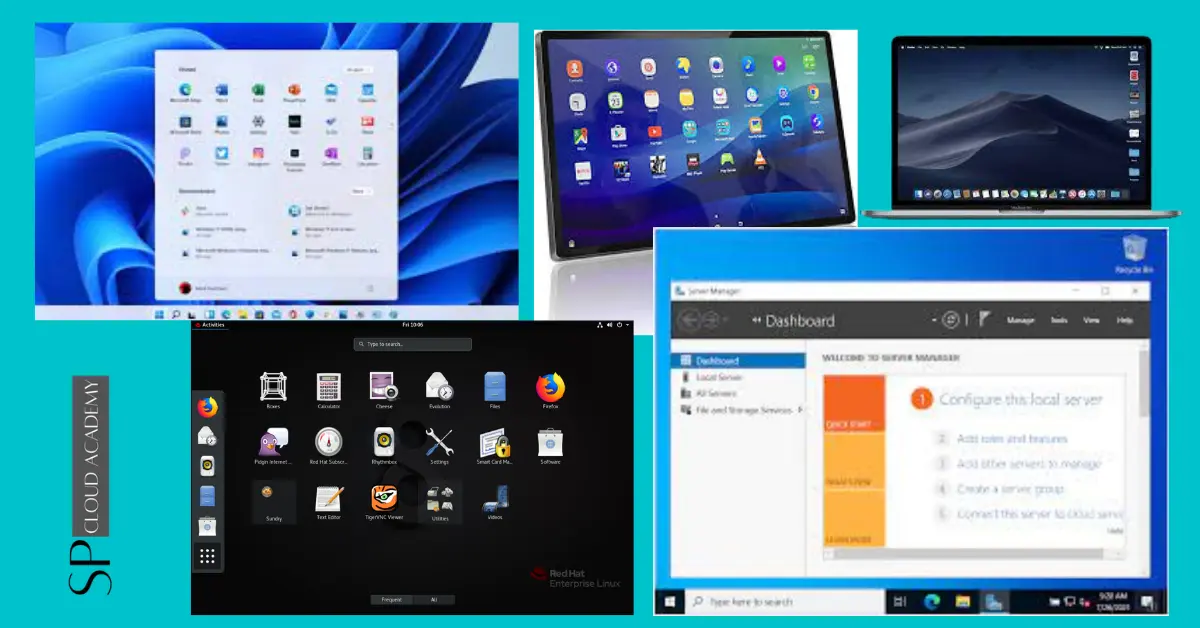Cloud-based Operating System Labs leverage cloud computing infrastructure to provide a virtual environment for testing and experimenting with various operating systems. These labs offer a scalable, accessible, and cost-effective solution for developers, students, and professionals to explore different OS configurations, perform software testing, and gain hands-on experience without the need for physical hardware. By offering remote access to diverse OS environments, these labs foster innovation, facilitate learning, and enable efficient software development and troubleshooting. They are a powerful tool for anyone seeking to master operating systems, enhance their IT skills, or optimize system performance in a cloud-centric world.
Feature and benefits
Features of Cloud-Based Operating System Labs:
- Virtualization Technology: Cloud-based OS labs leverage virtualization to create multiple isolated instances of operating systems on shared physical hardware. This enables users to run different OS versions simultaneously.
- Accessible Anywhere: Users can access the labs from any location with an internet connection, eliminating geographical constraints. This accessibility is particularly beneficial for remote learning and collaborative projects.
- Scalability: Cloud labs can easily scale resources up or down based on user demands. This flexibility ensures that users always have the necessary computing power to perform their tasks efficiently.
- Variety of OS Environments: Cloud labs offer a wide range of pre-configured operating systems, including various Linux distributions, Windows editions, and specialized OS versions. Users can choose the OS that best suits their needs.
- Snapshot and Restore: Users can take snapshots of their lab environments at any point in time. These snapshots serve as backups and allow users to revert to a previous state if an experiment goes awry.
- Resource Management: Cloud-based OS labs provide tools for monitoring and managing resources like CPU, RAM, storage, and network bandwidth. This helps optimize resource allocation for efficient usage.
- Collaboration: Multiple users can collaborate within the same lab environment in real-time. This feature is valuable for group projects, training sessions, or troubleshooting scenarios where teamwork is essential.
- Templates and Customization: Users can create custom OS templates or images to replicate specific configurations or software stacks across multiple instances, saving time in setup.
Benefits of Cloud-Based Operating System Labs:
- Cost-Efficiency: Eliminates the need for purchasing and maintaining physical hardware, reducing upfront capital expenses. Users pay for cloud resources on a pay-as-you-go basis.
- Flexibility: Allows users to experiment with different OS configurations, software installations, and settings without the constraints of physical hardware. This flexibility is valuable for software development and testing.
- Remote Learning: Ideal for educational institutions and online courses, as students and instructors can access and manage lab environments remotely, enhancing the learning experience.
- Real-world Experience: Provides hands-on experience in managing and troubleshooting operating systems, preparing users for real-world IT environments.
- Rapid Provisioning: Labs can be set up quickly, minimizing setup time and allowing users to focus on their tasks rather than infrastructure deployment and maintenance.
- Security: Reputable cloud providers offer robust security measures to protect lab environments and data, reducing security risks compared to self-hosted solutions.
- Version Control: Users can easily switch between different OS versions and configurations to compare performance, compatibility, and functionality.
- Global Access: Cloud-based labs support global collaboration and access, fostering a diverse community of users and learners from around the world.
- High Availability: Cloud providers offer high availability and redundancy, minimizing downtime and ensuring lab availability when needed.
In summary, Cloud-based Operating System Labs offer a versatile platform for learning, development, and testing, making them valuable for both educational and professional purposes. They combine the advantages of virtualization, accessibility, scalability, and resource management to create efficient, cost-effective, and collaborative environments for working with various operating systems.
Deployment
Deploying a cloud-based operating system (OS) lab for multi-vendor OS testing and learning involves creating an environment where users can experiment with various operating systems from different vendors. Here’s a step-by-step guide on how to set up such a lab:
Step 1: Define Objectives and Requirements:
- Clearly outline the objectives of the multi-vendor OS lab, such as testing interoperability, learning different OS environments, or evaluating compatibility.
- Identify the specific OS vendors and versions you want to include in the lab.
- Determine the expected workload and resource requirements, including CPU, RAM, and storage.
Step 2: Choose a Cloud Provider:
- Select a cloud service provider (e.g., AWS, Azure, GCP) that offers a wide range of OS images from various vendors.
Step 3: Set Up an Account:
- Create an account with your chosen cloud provider.
- Configure billing settings and ensure you have the necessary permissions to deploy resources.
Step 4: Network Configuration:
- Create a virtual network to isolate lab environments from other cloud resources.
- Set up subnets or network segments to group OS instances by vendor or purpose.
- Configure security groups or network security policies to control inbound and outbound traffic.
Step 5: Instance Provisioning:
- Launch virtual machines (VMs) or instances for each OS vendor and version you want to include in the lab.
- Choose the appropriate OS image and configuration for each instance.
- Specify the instance type based on your resource requirements.
Step 6: Resource Allocation:
- Assign appropriate CPU, RAM, and storage resources to each OS instance.
- Monitor resource utilization using cloud provider tools to ensure optimal performance.
Step 7: Security and Access Control:
- Implement security best practices, including firewalls, encryption, and access controls.
- Configure authentication and authorization mechanisms for users and administrators.
Step 8: Lab Image Creation:
- Customize the initial OS configurations, install required software, and configure settings for each vendor’s OS.
- Create master lab images for each OS vendor and version with these customizations.
- Take snapshots or create images of these master images for future replication.
Step 9: User Access and Collaboration:
- Set up user accounts and define access permissions for the lab instances.
- Implement collaboration tools or shared resources if multiple users need to work together on the same OS instances.
Step 10: Monitoring and Logging:
- Implement monitoring and logging solutions to track system performance, resource usage, and user activities for each OS instance.
- Configure alerts for critical events, such as high resource utilization or security breaches.
Step 11: Backup and Recovery:
- Establish backup and recovery procedures for lab instances and data for each OS vendor.
- Regularly back up critical configurations and data to prevent data loss.
Step 12: Testing and Validation:
- Thoroughly test the lab environment to ensure that all OS instances from different vendors behave as expected.
- Verify the effectiveness of security controls and access restrictions for each vendor’s OS.
Step 13: Documentation:
- Create comprehensive documentation that outlines how to access and use the lab environment for multi-vendor OS testing and learning.
- Include guides specific to each OS vendor and version.
Step 14: Scalability and Maintenance:
- Continuously monitor resource usage and scale up or down as needed to meet changing demands for different OS vendors.
- Perform routine maintenance tasks, including OS updates, security patching, and instance resizing for each vendor’s OS.
Step 15: Training and Support:
- Provide training and support to users to help them maximize the benefits of the multi-vendor OS lab.
- Offer resources and documentation specific to each OS vendor.
Step 16: Cost Management:
- Regularly review and optimize resource allocation for each OS vendor to avoid unnecessary costs.
Step 17: Compliance and Governance:
- Ensure that the lab environment complies with relevant industry regulations and organizational governance policies for each OS vendor.
Step 18: Backup and Disaster Recovery:
- Establish a disaster recovery plan for each OS vendor to ensure data integrity and service availability in case of unexpected incidents.
Step 19: Periodic Review:
- Conduct periodic reviews to assess the lab’s effectiveness, security, and compliance with evolving requirements for different OS vendors.
By following these steps, you can deploy a cloud-based OS lab that facilitates multi-vendor OS testing and learning, allowing users to explore various operating systems and gain valuable insights into their functionalities and compatibility.
Conclusion
In conclusion, Cloud-based Operating System Labs revolutionize learning, testing, and development by providing accessible, scalable, and cost-effective virtual environments. They empower users to explore diverse OS configurations, foster collaboration, and gain real-world experience without the constraints of physical hardware. These labs are indispensable tools in the cloud-centric landscape, enabling innovation and skill development across various domains.





